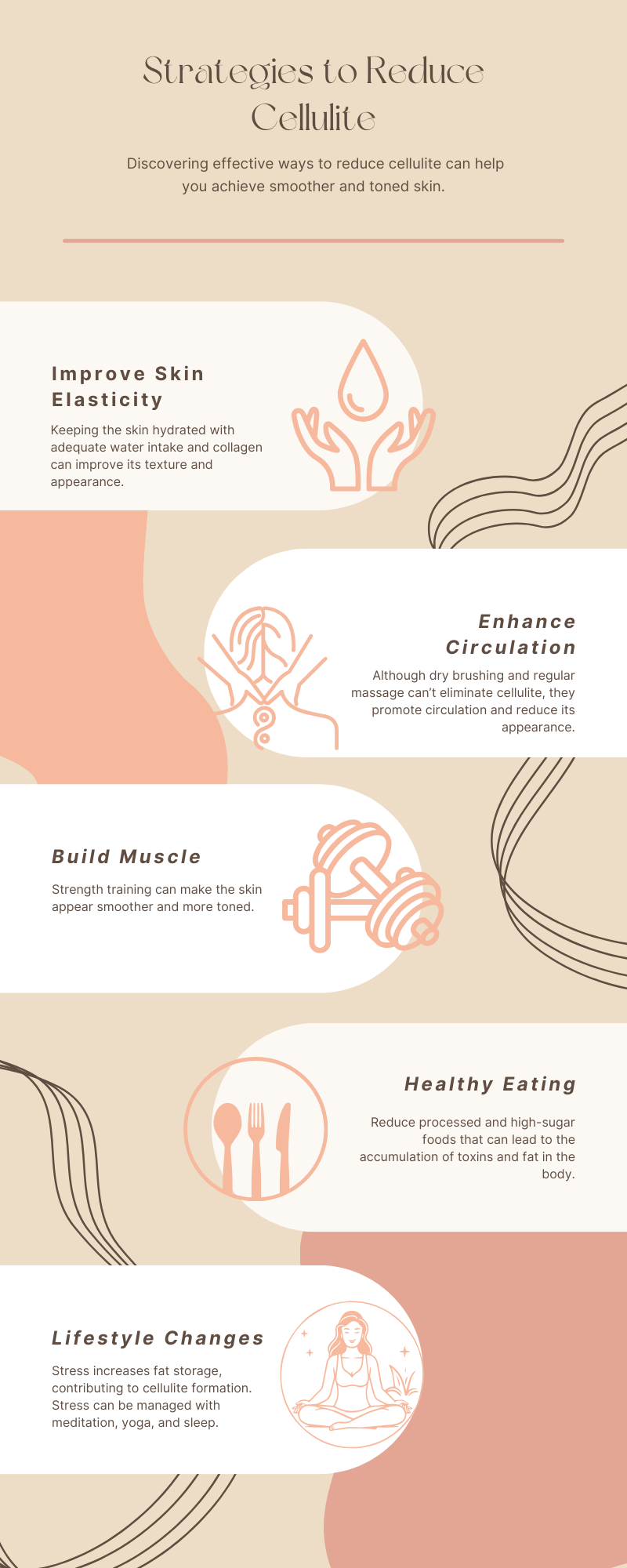No products added!
Cellulite is a common concern for many women, especially after significant weight loss. It appears as dimpled or lumpy flesh on the thighs, hips, buttocks, and abdomen. While cellulite is purely a cosmetic issue and not harmful to health, its appearance can be frustrating for those working hard to improve their body’s appearance. Understanding cellulite and exploring effective strategies to reduce its appearance can help you achieve smoother, more toned skin. This article delves into the causes of cellulite, why it may remain after weight loss, and provides comprehensive strategies for reducing its appearance.
Understanding Cellulite
Cellulite occurs when fat deposits push through the connective tissue beneath the skin. It’s more common in women than men due to differences in fat distribution, muscle, and connective tissue. Factors influencing the amount of cellulite include genetics, skin thickness, age, and body fat distribution.
Cellulite After Weight Loss
Losing weight can make cellulite more noticeable. Skin elasticity may decrease with age and rapid weight loss, making the skin’s surface more uneven. However, several strategies can help reduce the appearance of cellulite and improve skin texture.
Strategies to Reduce Cellulite
Improve Skin Elasticity
Hydration: Keeping the skin hydrated can improve its texture and appearance. Drink plenty of water and moisturize your skin regularly. The formula for calculating water intake is as follows: Water Intake Per Day = Body Weight (Kg) x 0.03. For example, a 70 kg person should consume 2.1 litres of water daily.
Collagen Intake: Collagen supplements may improve skin elasticity and hydration. Foods rich in vitamin C, like citrus (oranges, kiwi, lemon, grapefruit), bell peppers, strawberries, tomatoes, and cruciferous vegetables (broccoli, Brussels sprouts, cabbage, cauliflower), can also support collagen production.
Enhance Circulation
Dry Brushing: This technique uses a dry, soft-bristle brush to brush the skin gently. Although dry brushing doesn’t reduce cellulite, it can gently exfoliate your skin, remove dry, dead skin cells, stimulate circulation, promote lymphatic drainage and make you feel more relaxed.
Massage: Regular massage can increase blood flow and reduce fluid buildup in areas with cellulite. The foam roller, a long, tube-shaped piece of foam, is often used to break up fat. According to the American Council on Exercise, foam rollers won’t reduce cellulite.
However, a study conducted in 2010 examined the effects of mechanical massage, lymphatic drainage massage, and connective tissue manipulation on cellulite. According to the study, all three techniques effectively reduced fat and thigh circumference.
Build Muscle
Strength Training: Focusing on strength training exercises for areas prone to cellulite can help by replacing fat with muscle. Strength training can make the skin appear smoother and more toned.
Pilates and Yoga: These practices can improve muscle tone and skin elasticity, helping to reduce the appearance of cellulite.
Healthy Eating
Balanced Diet: Fruits (especially berries, rich in polyphenols, fibre, minerals, and vitamins), vegetables, whole grains, omega-3, and colourful complex carbs (that contain not only starch but also fibre), and protein can lower body fat, potentially reducing cellulite. In addition to herbs and spices, you should drink polyphenol-rich drinks such as green tea. Avoid sugar and alcoholic beverages, and reduce saturated and omega-6 oils from fried and hydrogenated fats.
Make kelp (seaweed) a part of your diet.
According to studies, ingesting kelp helps reduce cellulite by helping you lose five to ten percent of your body weight. Kelp contains fucoxanthin, an organic pigment found in plants that promote fat burning. In addition to adding kelp to soups and broths, you can also take it as a supplement. However, pregnant or breastfeeding women should avoid kelp supplements. You shouldn’t take kelp if you have thyroid issues.
Limit Sugars and Unhealthy Fats: Reducing the intake of sugary and greasy foods can help prevent additional fat cells from forming and exacerbating cellulite. Fat cells expand due to the storage of sugar.
Start your day with a serving of flaxseed.
In addition to supporting estrogen levels, flaxseed boosts collagen production. Flaxseed is a great food to include in your breakfast; you can add it to shakes or smoothies to combat cellulite.
Protein is essential; don’t skip it.
Lack of protein can quickly reduce skin firmness and elasticity, resulting in cellulite. In addition, if your diet lacks protein, you will consume more sugar and carbohydrates, which will cause unhealthy weight gain (including cellulite fat).
Topical Treatments
Creams and Lotions: Products containing caffeine, retinol, and antioxidants may temporarily tighten the skin, making cellulite less noticeable. Consistent application is vital.
Exfoliation: Regular exfoliation can remove dead skin cells and improve skin texture, potentially making cellulite less visible.
Advanced Treatments
Laser and Radiofrequency Treatments: These professional treatments can improve skin texture and reduce cellulite over time by stimulating collagen production and reducing fat cells.
Cryolipolysis (CoolSculpting): This non-invasive treatment freezes and kills fat cells, which may reduce the appearance of cellulite.
Subcision is when a needle breaks up the connective tissue bands, causing cellulite to reveal a smoother skin surface.
Lifestyle Changes
Regular Exercise: Consistent aerobic and strength-training exercises can help reduce body fat, improve muscle tone, and reduce cellulite.
Stress Management: High stress levels can contribute to cellulite formation by increasing fat storage. Meditation, yoga, and adequate sleep can help manage stress levels.
Managing Expectations
It’s essential to have realistic expectations when trying to reduce cellulite. Genetics plays a significant role in the development of cellulite, and eliminating it may not be possible for everyone. However, the strategies mentioned can significantly reduce its appearance and improve skin health.

Conclusion
Cellulite is a common concern, especially after weight loss, but it’s possible to reduce its appearance through lifestyle changes, dietary adjustments, and targeted treatments. Improving skin elasticity, enhancing circulation, building muscle, and considering advanced treatments can all contribute to smoother, more toned skin. While eliminating cellulite may not be achievable for everyone, these strategies can significantly improve skin texture and appearance, boosting confidence and overall well-being.
Word of caution.
This website provides information solely for educational purposes and should not substitute medical diagnosis or treatment.






